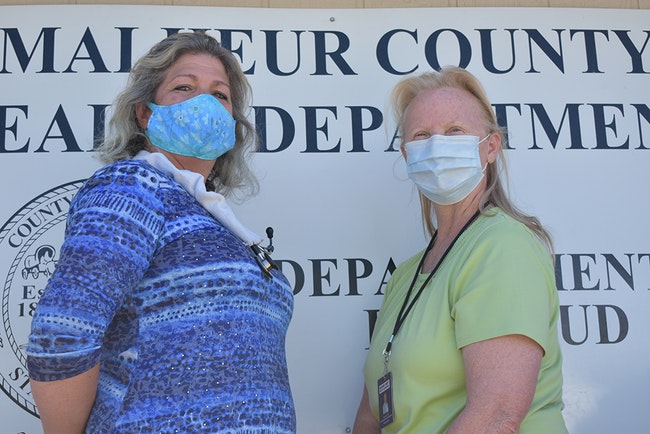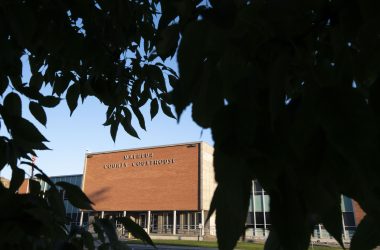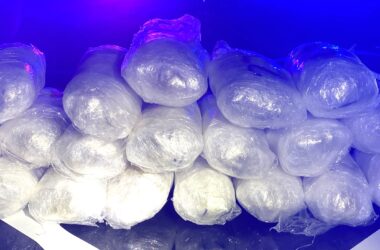
MaryLue Galligar (left) and Tana Waller are nurses and contact tracers at the Malheur County Health Department. (The Enterprise/Rachel Parsons)
Rebecca Stricker, a public health nurse and contact tracer at the Malheur County Health Department, is tasked with breaking some of the scariest news someone could hear at the moment.
“(You) have been named as a contact to a positive (COVID-19) case,” Stricker tells individuals who have been exposed to the coronavirus.
In the current pandemic, contact tracing consists of identifying and notifying those who have been in close contact with an individual who has tested positive for the coronavirus. The tracing is required by the state to decrease the spread of the virus.
In Malheur County, 33 people have tested positive for the virus since the first case was discovered in late March. As of Monday, none required hospitalization, one died, and 28 have recovered, according to county data.
The work of tracking down those who might have had contact with an infected person takes teamwork and time.
The work begins once a person has been identified as infected. A case investigator learns details about the person, including others who have been in close contact.
According to the Centers for Disease Control and Prevention, close contacts are defined as those within six feet of an infected person for at least 15 minutes 48 hours before symptom onset or a positive test result.
The list of such close contacts then goes to contact tracers, who in turn reach out to those have been exposed.
When it comes to delivering the news, Stricker said “understandably people become upset,” but she is grateful for the opportunity to educate and provide resources to those who have been named as contacts.
“Delivering news such as this is always a very delicate situation,” said Stricker. “Nobody wants to hear they have been exposed to a disease, particularly one that could be life threatening.”
For privacy reasons, those who might have been exposed aren’t told the identity of the person testing positive for the virus.
“The contact tracers are the ones that are following up with those contacts and making sure that they understand and that they have what they need so that they can stay home in quarantine for two weeks, and then they’re following up with them every single day,” said Sarah Poe, director of the Malheur County Health Department.
Sticker said contact tracers inform individuals about quarantine requirements, connect them to support services if needed and then check with them daily to assess if any symptoms of infection have emerged.
They also educate the contacts about how to stay healthy and prevent the spread of the coronavirus.
Poe said contact tracers ask about the individual’s household situation to figure out how to make adjustments for them to be isolated in a “sick room” in their house. Contact tracers also find out if arrangements need to be made for such needs as food delivery and child care.
The department can put people in hotel rooms if they can’t isolate or they have “unstable housing,” Poe said, but that hasn’t been needed yet.
“It’s really pretty personal because it’s saying you can’t leave your home for two weeks, so how are we going to make that happen?” said Poe.
Poe said contact tracers also spend considerable time trying to explain to an individual’s employer that even though the individual is not sick, they could develop symptoms during the two-week self-isolation period and need sick leave and assurance that their job is secure.
“That doesn’t always happen,” said Poe. “What employers want is a negative test, you know, and we don’t usually test people who don’t have a symptom. And even if they did get a test, they’re still within the incubation period of the virus — they could test negative and then test positive later.”
In Stricker’s experience, she said many of the close contacts she has reached out to have feared losing their jobs because they have to go into quarantine or face employers upset about being short staffed.
“For the most part, employers have been very accommodating,” Stricker said.
As a public health nurse, Stricker said she has “always been a contact tracer” for reportable communicable diseases. However, other staff at the department come from different backgrounds and had to be trained for the pandemic work.
The training for contact tracers consists of an online course that covers how to interview contacts, along with a self-paced data collection course, Stricker said. Further, the training covers topics such as background, epidemiology, surveillance principles of COVID-19, the basics of contact tracing and specific information about COVID-19 and how to prevent its spread.
The online training is about 10 hours, Poe said, but contact tracers also get department training from the case investigators to make sure they understand the process.
Poe said the department has nine contact tracers. Among them are five nurses, a health specialist, an office assistant, the head of the ambulance service district and an eastern Oregon epidemiologist, who helps the department a couple of times a week.
Of three case investigators, two are communicable disease nurses and one is the nursing supervisor, Poe said.
The Oregon Health Authority is recruiting contact tracers via a partnership with the state, local public health authorities and community-based organizations, according to the OHA’s contact tracing interest form. Those who are bilingual or have a background in health care and public health are preferred.
News tip? Contact reporter Bailey Lewis at [email protected]
SUBSCRIBE – $5 a month, automatically.
DONATE – to provide additional support. You can also mail a check: Malheur Enterprise, PO Box 310 Vale OR 97918. Donor identities are confidential unless the donor specifies otherwise. Thank you!




